There is one country we have visited where we feel even if we were to move there permanently, and live another 100 years, we would never really get a true understanding of
what the place is all about. That place is Japan.
It seems to be the nature and culture of the Japanese to keep their innermost thoughts hidden from view- at least those of our generation. They maintain a calm, placid exterior, and we find it impossible to ‘read” what
they are thinking. The younger generation moves too fast for us altogether, endlessly talking or texting on their cell phones.
Kyoto, an ancient capital of Japan, has more temples, monuments gardens than you can possibly visit in a limited amount of time. Seventeen of them are World Heritage sites, and all of them are noteworthy. For instance, below is Nijo Castle (Ninomaru Palace)
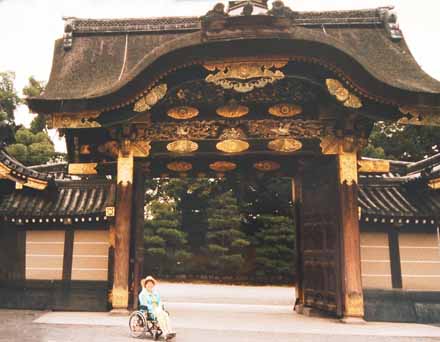
For more than 1000 years, Kyoto was the capital of Japan. Only within the last century was the capital moved to Tokyo. This is the entrance to the castle, built in 1603 by the Shogun Takugawa (Lord Toranaga if you watched Richard Chamberlain's miniseries years ago). The palace was built to impress the feudal lords who came here to pledge their allegiance to the new shogun. Nancy is impressed and dwarfed by the entryway- feelings the lesser lords must have felt also.
To
us, the most outstanding of all the treasures in Kyoto is Kinkakui, the Golden Pavilion, so called because its roof it covered with genuine gold leaf. Like the Jefferson Memorial in Washington, DC, the Opera House in Sydney, Australia, and a number of other such places, you cannot take an ugly picture of the Pavilion, no matter what season you visit. It is truly awesome and inspiring:
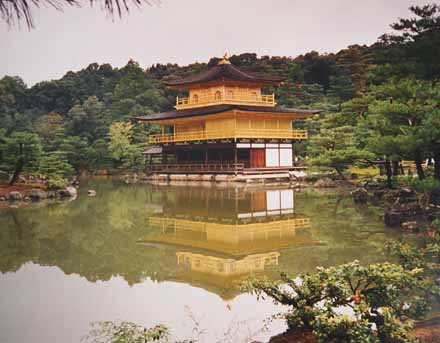
The site is ringed by cherry blossoms and has the same gossamer beauty when they are in bloom as the Jefferson Memorial in our hometown, Washington, DC. Originally built as a villa for the ruling Shogun in 1220, it was converted in the late 1300's by the Shogun Ashikaga Yoshimitsu, selected because it was the loveliest place he could find in all of Japan. He lived
there- on the top floor-for eleven years- until his death. The middle floor was occupied by Samurai and Ninja warriors whose only duty was to protect the shogun from enemies. The ground floor was used to receive and entertain VIP's come to visit the shogun.
The shogun was going to keep it as his own personal eternal resting ground, but he decided, in the end, that it was too beautiful to restrict only to himself, too lovely
to not be allowed to give pleasure to others. And so he donated this ‘loveliest place in Japan’, and it became a Zen temple.
As we got out of the car that brought us to this place, we could literally feel the
‘vibration’, the energy of some ethereal spirit here, hovering all around us. It was clear we were standing on “hallowed ground”.
A short walk from the pavilion is another of the World Heritage Sites in Kyoto, Ryoanji, the famous Zen Rock Garden Kyoto Japan, thought to date from the late 1400s. The garden contains 15 rocks set among raked white pebbles. It is left
to you to interpret and give whatever meaning comes to your mind as you stand in the presence of this beautiful garden.
Another site we found irresistible is Toji Temple, the largest and tallest 5 story pagoda in all of Japan. It was constructed in 794 AD to honor Kyoto for becoming the capital.
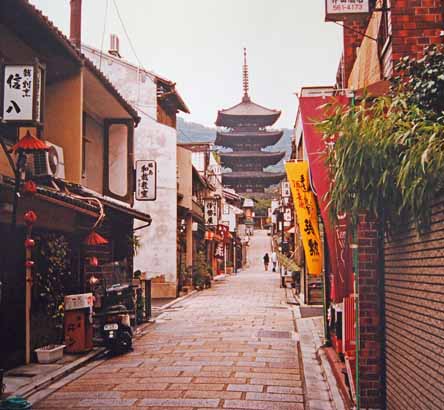
Look carefully at the left side of the picture. Do you see the two red umbrellas with the red balls hanging down from them? There is an interesting story about these:
Before it became the capital, Kyoto was a popular spot for R & R, and samurai warriors often came here after military campaigns and enjoyed shopping along these ancient streets. The red bowls hanging down were filled with oats for the horses, and as the horses stopped to munch the oats, the shopkeepers would come out and sell goods to the samurai
*************************************************
We left Kyoto on the High Speed Bullet Train, connecting to Tokyo (and most of the major cities on the main island). The train is easy to navigate and we had no trouble. Everyone is respectful and most helpful to those of us with "additional needs".
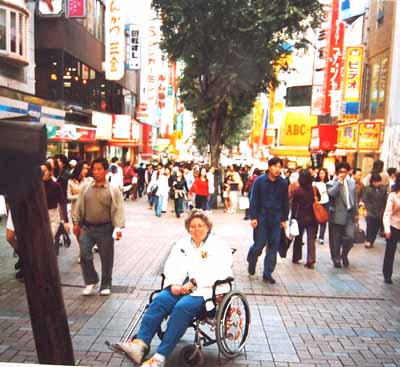
We stayed in the heart of Tokyo and went shopping! Bought a camera, in fact, at way below what it would have cost in the States. In the larger department stores, you are assigned a "Personal Shopper" who knows where everything your size is located. We, who come from a "You don't see it? We don't got it" culture- were blown away by the service. Shopping- for sure. If you want culture, however, stay in Kyoto.
One of our most pleasant experiences was a very full day trip out of Tokyo to visit glorious Mt. Fuji. Leave time for a cruise on the surrounding lake and cable car at Hakone, and then return to Tokyo on the high speed (200mph+) train.
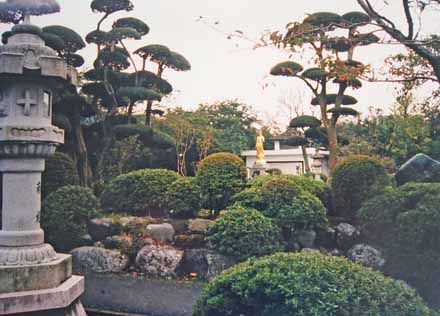
Unbelievable serenity in the gardens of the Golden Buddha
At Hakone, we spend a rejuvenating few hours in the Temple of the Golden Buddha If we were to do it again, we would stay overnight in the area, rather than push ourselves. There is simply too much to take in on a day trip. Although exhausting, it was unforgettable. |
